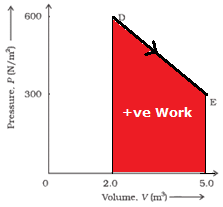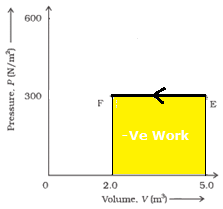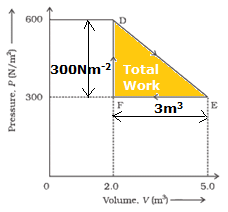A thermodynamic system is taken from an original state to an intermediate state by the linear process shown in Fig. (12.13)

Its volume is then reduced to the original value from E to F by an isobaric process.
Calculate the total work done by the gas from D to E to F
For any thermodynamic process represented by a curve with x axis representing volume and y axis representing Pressure, area under the curve between two points gives the work done in the process, further if volume is increasing the work done is positive , if volume is decreasing the work done is negative.
Now as we can see along DE the volume increased from 2.0m3 to
5.0m3 so work done along DE is positive and area under DE with x axis is the magnitude
As shown in figure

Now as we can see along EF the volume decreased from 5.0m3 to
2.0m3 so work done by the gas along EF is negative and area under EF with x axis is the magnitude
As shown in figure

Positive and negative work cancel each other so the net magnitude of work done by gas is the area of triangle DEF and magnitude will be positive
As shown in figure

Now to find the area we know area of a triangle is given by
A = 1/2 × Base × Height
Here Base of triangle is EF, Height is DF
EF = (5.0m3 – 2.0m3) = 3.0 m3
FD = (600Nm-2 – 300Nm-2) = 300Nm-2
So the work done is
W = 1/2 × EF × FD
= 1/2 × 3.0 m3 × 300Nm-2
= 450 J
So the total work done by the gas from D to E to F in the thermodynamic process is 450 J